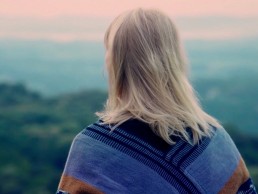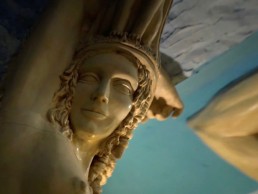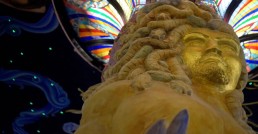In June this year, filmmaker Ivan Olita came to Damanhur to realize a video for the NOWNESS series “Retreats” that explore communities and individuals living by their own rules. In the video, we follow the life of Celastrina, a young Damanhurian citizen from Stockholm, Sweden, that came to Damanhur only 3 years ago. Through her story, the video explores the spiritual and social values of Damanhur, and how they’re applied in the personal lives of the Damanhurian citizens.
When asked about her experience of the filming, Celastrina answered:
“It’s always interesting to talk about your own story and the choices that brought you to your current life situation, because in doing that you need to reflect on them, and as a result it’s like you get to know yourself better. In this case, not only representing myself but the whole community made me of course a bit nervous, especially because since coming to Damanhur I have come to recognize that although everyone in the community shares the same core values, each individual perceives Damanhur differently depending on their own story and situation.
The final video, however, is a beautiful and poetic representation of just that; a personal story that is weaved into a bigger story. So, I think that Ivan did a great job in his artistic interpretation of the community. For me, studying and working with film, it was also an interesting and enriching experience to see how Ivan, as a professional filmmaker, works on set.”

Below you can follow an interview with Ivan about his experience of Damanhur published on NOWNESS in connection to the video.
‘IT’S SURPRISING… ASTONISHING’
An interview with Ivan Olita
How did you first discover Damanhur—and what made you decide to film here specifically? What drew you to it?
“I first discovered Damanhur when I was a teenager. I remember a friend of mine telling me about it. At that time, Falco, the founder of the community was still alive and his actions in the community had a lot of media exposure in Italy. We are ruled by the Vatican and everything that is not within the Catholic teaching is deemed somehow heretic. I remember being very curious about this community. Also, I had the interest in shooting a trilogy about faith. I went to Kyoto to document the Tendai Monks that undergo excruciating training to reach enlightenment, in Italy to document the most important exorcist for the Vatican and this seemed to be an interesting final chapter.”
What surprised you about Damanhur?
“The whole idea of a community for esoteric knowledge in the middle of a tiny Italian village is pretty surprising. Also Damanhur is not self-contained. It is actually made up of several micro-villages spread across the valley so, even from a social and architectural perspective is pretty interesting to see how the two integrate. You would expect Damanhur to be absolutely self sufficient and I guess that they are from an academic perspective but there is an inherent ‘Italianity’ in the system that’s inevitable given the dislocated nature of the community. So it’s an interesting patchwork of your casual Italian restaurant next to some Damanhurian owned business next to a compound of houses in where to study some esoteric science. Aside from Damjl, the headquarters of the community, you don’t really realize you’re in Damanhur, it just feels like being around Italian valleys. The Temple (well, countless books have been written about it but regardless) is surprising, astonishing, really.”

Did the spirituality of the site influence how you approached the shoot? Did you feel like a participant when you were there, or more of a distant observer—an anthropologist or an acolyte?
“I always feel like some sort of anthropologist and although I don’t have a systemic approach to my subjects, I do have to analyze them to an extent and relate my analysis to other people, other cultures and other subjects. That said I also tend to develop a very strong connection with whoever I shoot with, it is almost a sort of a spell, so I’m always really involved. In this case specifically with Celastrina (Rebecka) who is the same age as I am and comes from a somewhat similar background. While we were there shooting in the mountains I often times found myself thinking… -What if I decided to just come and live here?-”
Would you return to Damanhur, and why?
“I would totally return! I’m planning to go there soon. I consider Damanhur a center for human potential development. There is nothing that far out about that. And they host all kinds of weeklong workshops if you are interested in developing and or studying some alchemy, lucid dreaming or exploration of time and past lives.”

You’ve previously shot a film about Catholicism and exorcism, which was premiered on NOWNESS. How does this type of spiritual society differ from the more ancient form of Christianity?
“The main difference without entering in too much detail is that Damanhurians don’t follow any kind of dogma, whereas Catholicism is a pretty dogmatic religion. The exorcist I met was very enlightened though and he could trace back to the roots of his religious beliefs, he knew the holy writings and with him Christianity became more of a metaphysical experience. Damanhurians on the contrary believe in personal empowerment, and in the hidden laws of the universe. There is no dogma, it is more about uncovering ancient knowledge and putting it to use.”
Based on what you saw and shot, why might people choose to live in Damanhur or, for that matter, any spiritual society outside of normal social structures? Is this a reaction against the cruelties, alienation, and overload of modern society?
“People in Damanhur, as well as in other communities around the world such as Auroville (or to a lighter extent Esalen in California) are just trying to question the way we can live life. I think these communities are obviously part of the 1960s counterculture but are definitely having a comeback now.”
—Interview by Owen Gwynne Vince
Interview published by NOWNESS October 8, 2018.







